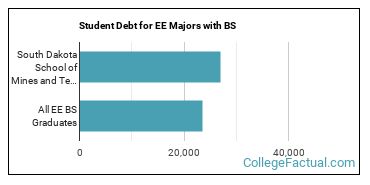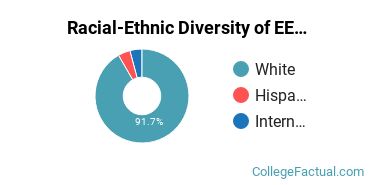 by our College Data Analytics Team
by our College Data Analytics TeamThe main focus area for this major is Electrical Engineering. For more details on this concentration, visit its profile page.
Electrical Engineering is a major offered under the engineering program of study at South Dakota School of Mines and Technology. We’ve pulled together some essential information you should know about the bachelor’s degree program in EE, including how many students graduate each year, the ethnic diversity of these students, and more.
If there’s something special you’re looking for, you can use one of the links below to find it:
If you're having trouble deciding which school is best for you, you may want to check out our many college rankings. The bachelor's program at SD Mines was ranked #182 on College Factual's Best Schools for EE list. It is also ranked #2 in South Dakota.
Here are some of the other rankings for SD Mines.
During the 2019-2020 academic year, part-time undergraduate students at SD Mines paid an average of $404 per credit hour if they came to the school from out-of-state. In-state students paid a discounted rate of $258 per credit hour. The following table shows the average full-time tuition and fees for undergraduates.
| In State | Out of State | |
|---|---|---|
| Tuition | $7,740 | $12,120 |
| Fees | $3,280 | $3,280 |
| Books and Supplies | $2,050 | $2,050 |
| On Campus Room and Board | $7,980 | $7,980 |
| On Campus Other Expenses | $4,400 | $4,400 |
Learn more about SD Mines tuition and fees.
One way to think about how much a school will cost is to look at how much in student loans that you have to take out to get your degree. EE students who received their bachelor’s degree at SD Mines took out an average of $27,000 in student loans. That is 15% higher than the national average of $23,573.

The median early career salary of EE students who receive their bachelor’s degree from SD Mines is $64,196 per year. That is 3% lower than the national average of $66,265.

Online degrees for the SD Mines EE bachelor’s degree program are not available at this time. To see if the school offers distance learning options in other areas, visit the SD Mines Online Learning page.
Women made up around 16.7% of the EE students who took home a bachelor’s degree in 2019-2020. This is in the same ballpark of the nationwide number of 15.7%.

Around 4.2% of EE bachelor’s degree recipients at SD Mines in 2019-2020 were awarded to racial-ethnic minorities*. This is lower than the nationwide number of 36%.

| Race/Ethnicity | Number of Students |
|---|---|
| Asian | 0 |
| Black or African American | 0 |
| Hispanic or Latino | 1 |
| Native American or Alaska Native | 0 |
| Native Hawaiian or Pacific Islander | 0 |
| White | 22 |
| International Students | 1 |
| Other Races/Ethnicities | 0 |
Electrical Engineering students may decide to major in one of the following focus areas.
| Focus Area | Annual Graduates |
|---|---|
| Electrical Engineering | 24 |
You may also be interested in one of these majors related to electrical engineering.
| Related Major | Annual Graduates |
|---|---|
| Chemical Engineering | 43 |
| Civil Engineering | 49 |
| Computer Engineering | 15 |
| Mechanical Engineering | 99 |
| Metallurgical Engineering | 22 |
*The racial-ethnic minorities count is calculated by taking the total number of students and subtracting white students, international students, and students whose race/ethnicity was unknown. This number is then divided by the total number of students at the school to obtain the racial-ethnic minorities percentage.
More about our data sources and methodologies.